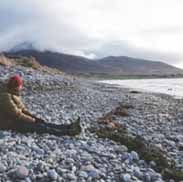Earth Science Unit 3 Test
Unlock all answers in this set
Unlock answersquestion
The earth's interior heat and pressure drive a process of heat transfer in the mantle called _____.
answer
convection
question
When energy is transformed, some is used, but most is released as unusable heat energy, according to the _____ law of thermodynamics.
answer
second
question
Energy is the ability to do _____ . The study of energy and its changing forms is called _____.
answer
work, thermodynamics
question
In the nitrogen cycle, once a consumer gains nitrogen nutrients from animals or plants, it recycles these nutrients back to the earth by _____.
answer
releasing waste and decomposition
question
Starting from the center of the earth, number its layers in the correct order.
answer
1. Inner core 2. Outer core 3. Lower mantle 4. Upper mantle (asthenosphere) 5. Crust (lithosphere)
question
Mr. Goldsmith suggested that animals must capture energy from their environment. An example of this would be _____.
answer
a rabbit eating grass
question
The lithosphere floats on the asthenosphere like glass on clay. When the clay moves, the glass moves. The movement of the lithosphere is _____.
answer
Plate tectonics
question
In the rock cycle, rocks can change into three different forms. These are _____.
answer
igneous, sedimentary, and metamorphic
question
The atmosphere provides the biosphere with necessary gases to live and breathe. This is an example of how Earth's spheres are _____.
answer
interdependent
question
In the phosphorus cycle, phosphorus can recycle through waste products, decomposition, and ____ of terrestrial and aquatic ecosystems.
answer
food chains
question
In the hydrologic cycle, after water precipitates to the surface, it can return to the atmosphere by processes of _____.
answer
evaporation and transpiration
question
During the carbon cycle, carbon cycles from plants through the ____ then recycles back into the soil by ____, like fungi and bacteria.
answer
food chains, decomposers
question
The four main spheres of Earth are the _____.
answer
atmosphere, hydrosphere, lithosphere, and biosphere
question
In the tectonic cycle, new but recycled lithosphere rises to the ground at ____ boundaries and can be subducted at ____ boundaries.
answer
divergent, convergent
question
Choose the pieces of evidence that supported the existence of Pangaea and continental drift theory.
answer
Fossilized plants and animals of the same species found on separate continents, Geological features, such as mountain ranges, that align on matching coasts of different continents
question
The _____ law of thermodynamics states that energy can't be created or destroyed. Two natural sources of energy on Earth are the _____.
answer
first, sun and core of earth
question
Carbon is released to the atmosphere by _____.
answer
respiration and burning of fossil fuels and wood
question
Match the layer with its correct description. 1. inner core 2. outer core 3. lower mantle 4. upper mantle 5. crust
answer
1) Made of solid iron about 1,200 km thick. Temperature is about 7,000°C. 2) Very dense liquid of iron and sulfur about 2,250 km thick. Temperature is about 4,000°C. 3) Solid rock about 2,200 km thick. Temperature is about 3,000°C. 4) Solid rock about 720 km thick that flows from plasticity. Temperature is about 850°C. 5) Plates that average about 30km in thickness and 25°C in temperature.
question
For each boundary, choose the correct resulting formation or primary activity. 1. Convergent 2. Divergent 3. Transform
answer
1. Ocean trenches and mountains 2. Ocean ridges and rift valleys 3. Tremors and earthquakes
question
During the rock cycle, rocks get broken apart by weathering, carried along by erosion, and eventually deposited in a body of water. What happens next?
answer
Compaction and cementation into sedimentary rock, then heat and pressure into metamorphic rock.
question
Which of the following are processes of nitrogen and ammonia conversion that make nitrogen absorbable by plants?
answer
nitrogen fixation, ammonification, and nitrification
question
Approximately how much energy is transferred from one step in a food chain to the next?
answer
10%
question
Plants absorb water from the soil to live and grow. This is an example ____ of of the biosphere, hydrosphere, and lithosphere.
answer
sphere interaction
question
The continents at one time were one supercontinent called ____. This supercontinent was surrounded by an ocean called ____.
answer
Pangaea, panthalassa
question
Phosphorus isn't as abundant as nitrogen or carbon because it is contained in the ____ and released with ____ processes, which can take a long time.
answer
lithosphere, geological
question
____ found evidence that the continents were joined together at one time.
answer
Alfred Wegener
question
You can follow the flow of energy in an ecosystem by following its food ____ or ____.
answer
chain, web
question
During convection, hot material ____ then moves to the side and ____. This circular pattern is called a convection current.
answer
expands and rises, cools and sinks
question
Match the plate boundary with the best analogy description: 1. Convergent 2. Divergent 3. Transform fault
answer
1. Cars crash in a head on collision 2. Lovebirds part and go separate ways 3. rubbing your hands together
question
Select the best description for each cycle: 1. hydrologic 2. rock 3. tectonic 4. carbon 5. nitrogen 6. phosphorus
answer
1. It's all about water 2. erosion, deposition, metamorphism 3. subduction, uplift, and mantle convection 4. photosynthesis and respiration 5. Its all about special bacteria 6. housed mostly in rock material
question
Earth's geochemical and biogeochemical cycles are important because they tend to maintain a balance of Earth's materials.
answer
True
question
On Earth, old matter is recycled into new matter.
answer
True
question
In the hydrologic cycle, water from the ocean ____ into the atmosphere where it can ____ and change back into tiny water droplets.
answer
evaporates, condense



